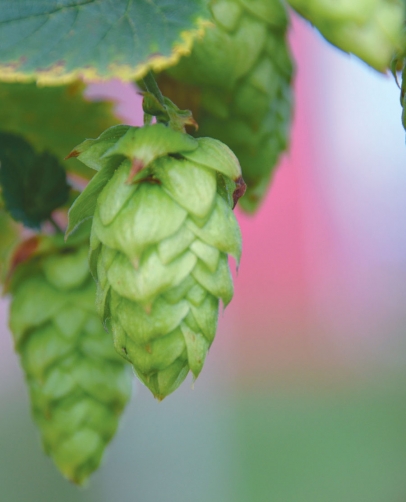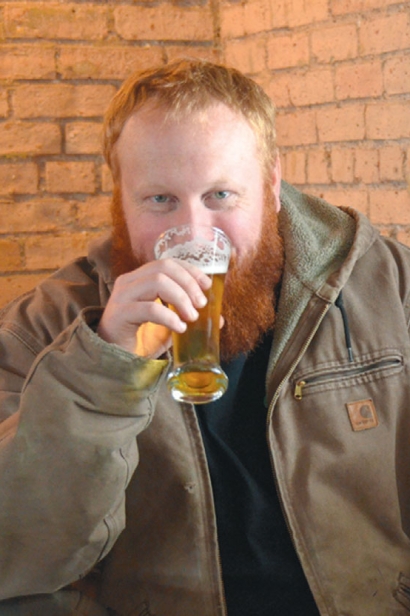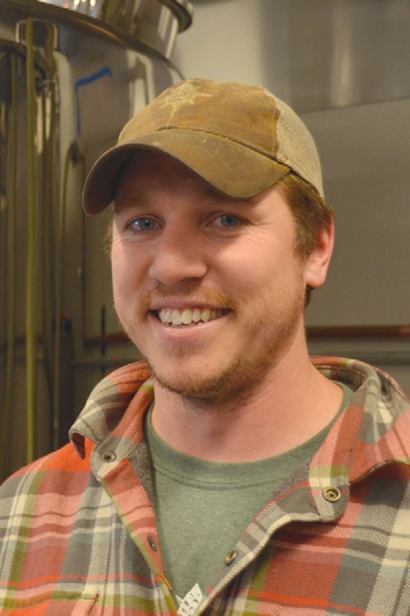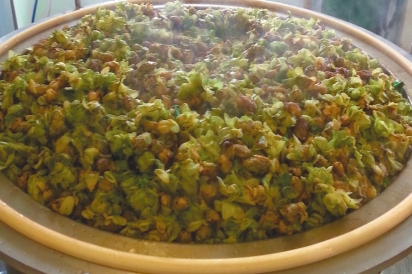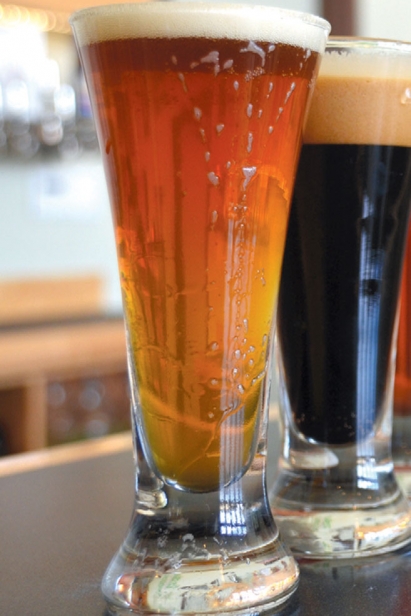Boiling Cauldrons of Bitters and Bouquets
Michigan Brewers Explain Hops
Fresh from my winter mini-course on hop growing with Brian and Amy Tennis of New Mission Organics, I decided to take the next step and learn about using hops in beer. Full confession here: I am a neophyte in the brewing world. However, perhaps I am not alone in confronting the plethora of new breweries and hop farms that now surround us in Northern Michigan?
What makes an IPA a double IPA? And what are the steps and options available to brewers when crafting their signature beers? In particular, how do these talented and creative individuals view and make use of the local hops that are more and more available to them each year?
To get a handle on this subject I set out to taste my way through many beers. Four of our local haunts became my classrooms, their head brewers my guides: John Niedermaier at Brewery Terra Firma in Traverse City, Tony Hansen and Sam DeCamp (quality control) at Short’s Brewing Company in Pleasantville, Andy Largent at The Filling Station in Traverse City, and Steve Lutke at one of the newest additions to the brewing landscape, Hop Lot Brewing Company in Suttons Bay.
Hops, the female flowers/cones of the creeping bine (vines that climb the coconut fiber/coir guide ropes, their stiff hairs hooking their stems as they creep up) are used to bitter, to boost a beer’s head retention, to limit undesirable bacteria and to flavor.
With a particular beer in mind, brewers choose their hops based on acid profile (higher Alpha acids for bittering and preserving; higher Beta acids for flavor and bouquet). They then decide at which point or points in the fermentation process to add the hops and in what form (fresh or dried, whole or pelletized).
When brewers create IPAs there is attention to initial and lingering bitterness, malt sweetness and the bouquet. Different ratios and varieties of hops and malts are used and blended to their unique versions. A whole range of other ingredients including spices, herbs, honey, maple syrup, cocoa, coffee, fruits and even vegetables can be added as the brewer sees fit. But for this article, we’ll focus on hops.
This past fall you may have been lucky enough to imbibe a wet-hopped ale at one of our local breweries, such as Short’s Small Batch Kind Ale, with hops from Michigan Hop Alliance, or their Devil’s Lettuce, a wet-hopped lager using hops from Empire Hop Farms.
Only because we have local hop farms are our brewers able to experiment and offer such specialty brews. Literally, these wethop beers are made with hops just hours after harvest. They are the true definition of “fresh.” So, if you haven’t already, mark hop harvest season (September) on your calendar. These small offerings come and go in the flash of an eye. And you, being resident of a region rich in breweries and hop farms, are luckier than you know to be able to enjoy such delightful rarities.
On a rainy, cold day this past December I visited with John Niedermaier at Brewery Terra Firma. It was the first stop on my journey, and John took up the challenge of sharing his views on using hops in his beers.
John has been brewing for 23 years, 18 as a commercial brewer with stints at Traverse Brewing Company and Right Brain. In his new facility, the environmentally designed brew pub, farm and production facility Brewery Terra Firma, just south of downtown Traverse City, he is producing his flagship beers (Manitou Amber Ale, Gladstone APA and Karma Palace IPA), and reveling in the creative possibilities of seasonal and specialty brews, which he puts on tap throughout the year.
He described to me how he sought to bitter, not necessarily to flavor, with hops in his Beehive Honey Blond, seeking to emphasize flavor notes of local honey (from Hilbert’s Honeyland) and sweet basil. The honey flavor is subtle, not cloying, bringing bright and floral notes to this light-bodied warm-weather beer. Hops are added early in the boil, counterbalancing the sweetness of the malt and honey.
Alice Run Amok IPA puts hops front and center. It features hops from the Northwest Michigan Horticulture Research Station and is rich in interesting and unusual flavors: grassiness, earthiness and citrus. John uses the hopback method [see sidebar] to infuse his sugary wort with the flavors of whole hop cones. The resulting brew is golden brown, tea-colored, with a beige cream head. The alcohol extracts flavors and aromas from the hops, but no bitterness, no heat. Grassy, straw and herbal notes fill the mouth with the first sip, a touch of toasted grains in the bouquet.
John’s Soul Butter, 8.2% takes the art of playing with hops to its outer limit. Again using his preferred hopback method, he puts in Simcoe, Chinook, Columbus, Cascade, Crystal and Magnum hops, some whole cone. Flavors of exotic fruits, fresh pineapple and citrus surprise the palate. Bright zest and floral notes sing on the tongue, the volatile alpha and beta oils are in the fore, with minimal bitters, coating and soothing the palate, giving a sensation of sweetness where there is none. Not surprisingly, there’s a waiting list of distributors for this one, which John puts somewhere between a Triple IPA and an Imperial IPA—if you must assign it to a category.
Does Michigan have a particular hops terroir?
Across the board our brewers are excited about being able to locally source hops. Those who’ve been actively brewing for years have noted an evolution in both availability and quality.
It was near-blizzard conditions the day I waded through waist-high snowdrifts into the bright and welcoming hub of The Filling Station. Brewer Andy Largent was ready for me and a beer-loving friend and we dove straight into a discussion on his experience with Michigan hops. “The first few years it was more of a crapshoot, but now we can actually predict better what we’ll be getting and production is far more stable.”
Andy believes Michigan hops tend to be higher in oils than those of the West Coast, and offer more spicy, earthy and bitter notes. Comparing West Coast to Michigan, he used the variety Chinook as an example: West Coast Chinook can be counted on to contribute piney notes; its Michigan cousin offers more grapefruit, pineapple and citrusy notes.
In his Hop Line, a lighter-bodied IPA, Andy uses Columbus, Cascade, Summit and Centennial hops in the boil for bittering, also extracting some dank, garlicky notes from Summit and Columbus. He then applies the dry hop method with Bravo, Pekko and Cascade, adding oat flakes to give body and a touch of sweetness. The result is between a Pale Ale and an IPA: fruity, floral, lightly resinous, not too bitter, with 5 percent alcohol.
Andy fills me in on Pekko, an example of a trademarked hop. Grown in the Pacific Northwest, it is brought in, processed and distributed by New Mission Organics. More and more the goal for hops growers is to trademark, license or arrange proprietary agreements around specific hops. There are many out there beyond the standard three (Cascade, Chinook and Centennial), and growers are working hard alongside researchers to develop new hops with unusual flavor profiles. Brewers are taking up the challenge to develop beers around these new hops and are willing to pay the steeper prices these exclusive hops command.
Steve Lutke of Hop Lot Brewing Company elaborated on the consistency and predictability of flavor profile when using Michigan hops. He, like most brewers, learned with the variety standards set by the West Coast. “In the beginning it was very hard to add these [local] hops in, as I didn’t know them as well. Perhaps not as piney and foresty as I was hoping, but more fruity. Learning how to use them has been a voyage.”
When I asked Steve point blank what he thought of our local terroir, he replied, “There are some varieties I would never change out. Our Rye IPA is 100% Leelanau Peninsula Centennial hops. I wouldn’t trade them out for any West Coast variety… We use a lot of local Cascade—grapefruity, slightly floral, citrus. I personally feel I get more of an earthy feel in our local varieties, an extra note. The aromatics are amazing.”
Tony Hansen, who arrived at Short’s Brewing in 2007 as a mechanically inclined assistant with a culinary background, is now brewer at the Pleasantville location. He’s observed the typicity of Michigan hops becoming less pronounced as the growers become more skilled. “A few years ago, Michigan Cascade would have been more dank, grassy, less citrusy, but nowadays it is almost indistinguishable from the West Coast version: grapefruit, floral and orange zest… Each year we see an improvement in the quality, in the plant, in the processing, the packaging and delivery.”
As one of our larger local breweries, Short’s must still source most of their hops from the West Coast. However, they enjoy showcasing local hops in their small-batch specialties, such as Summit in Bona Fide Legit IPA, where its resinous and dank “delicious onion and garlic” personality shines, or Gleaner Boc made with Michigan Hop Alliance Cascade.
Hop Lot brewer Steve and his brother Drew are amongst the most recent arrivals to our Northern Michigan brewing scene. Steve, a fan of organic chemistry in college, explained how he sort of fell into home brewing when he found himself in a flexible job that gave him free time during the day. This led to brewing all the beer for his wedding, rave reviews from friends and family, and offers to help him do it full time. Hop Lot, a simply designed, rough-beamed brewery pub and spacious outdoor beer garden in the woods just off the Suttons Bay leg of the TART trail, opened just one year ago.
New and small, it was difficult to get contracts with the established West Coast hop sources. It’s a seller’s market, and the competition is fierce. Having hop growers within easy distance of their brewery and beer garden has been invaluable.
“We pay a little bit more of a premium. We form relationships with the farmers. We visit them, learn about how they harvest, process, etc. We can actually go and pick up the hops at the farm, learn how it all went, what the quality is, get it from the source. In some ways it was fortunate we couldn’t get the typical contracts but had to go directly to the growers.”
Steve proudly affirms that he puts at least one local hop variety into all of his beers, with a few of them being 100% local. When I visited on a sunny, snowy early spring day, I was able to congratulate him on his shiny new stainless tanks, sized to produce the quantities needed to satisfy the increasing demand.
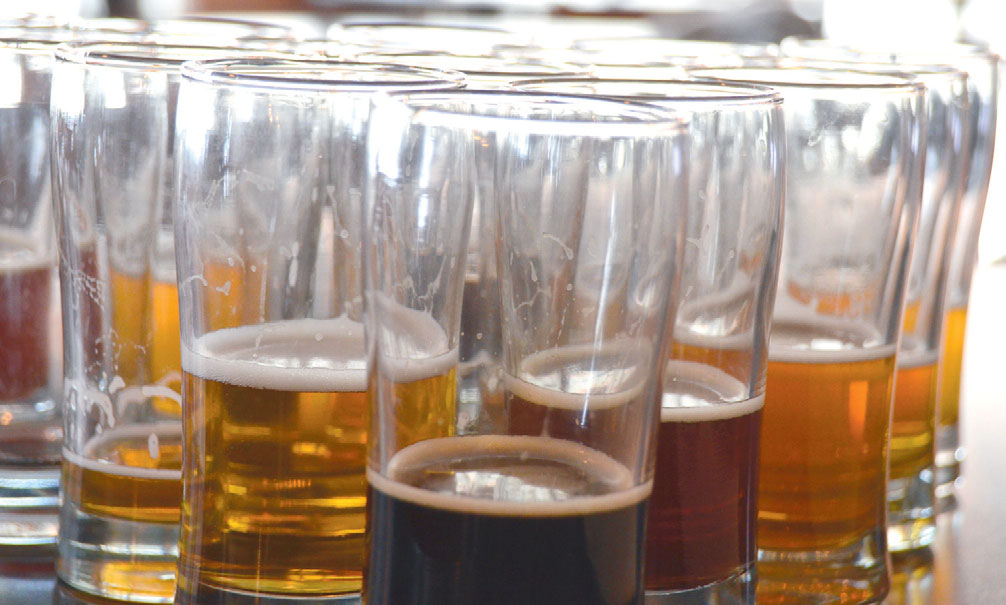
Our local hop growers began with the standard, popular varieties, focusing on those best adapted to Michigan’s climate: Centennial, Chinook, Cascade. These all have very similar flavor profiles—grape-fruity and tropical—and are now pretty much on a par with anything available from the more established West Coast sources. However, there are nuanced differences yet. Steve described to me a note of earthiness when he tastes Michigan Centennial, quite subtle, but adding extra dimension to his beers.
I asked Brian Tennis what he is growing in his hop yards this year, and he sent me the following list. Clearly, the local offerings are expanding.
- Brewer’s Gold
- Bitter Gold
- Cascade
- Cashmere
- Centennial
- CF69™
- Chinook
- Columbus
- Columbia
- Crystal
- Dr. Rudi NZ
- Fuggle
- Galena
- Green Bullet NZ
- Kazy Gold™
- Kirin II JP
- Magnum
- Nugget
- Raku NZ
- Sorachi Ace JP
- Saaz
- Summit™
- Strisslespalter FR
- Tahoma
- Tardif de Bourgogne FR
- Zeus
DISCOVER, SELECT, EXPERIMENT.
While we sipped and tasted through at least ten beers, ales, stouts and of course IPAs, Short’s Tony Hansen and Sam DeCamp described to me the birth of the monster IPA Liberator (a special 30th birthday IPA for founder Joe Short) coming in at 8.2 percent alcohol. Hops, to bitter and to flavor, were added every four minutes during the boil, a “shotgun approach to get every possibility from every addition; the ultimate utilization out of the boil,” says Tony. A blend of multiple hops—Amarillo, Simcoe, Columbus, Palisades, Cascade and Chinook—went in (with perhaps a few others). To emphasize the citrusy personality of this beer, orange and lemon zests were added post-fermentation. The result is quite tart, very grapefruit pith and lime. “A multiplied mash-up of his [Joe Short’s] two favorite beers, Huma Lupa Licious and Nice ‘n Spicy.”
IPAs are made all over the US now. It is the iconic American artisan brewer’s brew, and each region has its style. But what is the style of Upper Lower Michigan? We have quite a number of brewers, each quite individual and creative. If I were you, I’d take up the challenge, and go tasting to find out.
Basic Brewing Steps
1. Milling—the malted barley is run through a mill to be crushed into grist.
2. Mashing—The grist is steeped in hot water in a mash tun (vessel) to convert starches to fermentable sugars.
3. Lautering—The grain is separated from the sugary liquid, called wort.
4. Sparging—Hot water is used to extract the remaining sugars from the grain.
5. Boiling—The wort is transferred to a boil kettle. Hops are added at this stage to boil and provide bitterness.
6. Whirlpool—The wort is spun to remove spent hops and coagulated proteins.
7. Wort cooling—The wort is cooled before the yeast is added.
8. Fermenting—The cooled wort is transferred to fermentation tanks, yeast is added and the sweet liquid begins its transformation into beer.
9. Conditioning—Fermentation slows, spent yeasts drop to the bottom of the tank, beer is cooled then transferred to a conditioning tank for flavor maturation, clarification and/or carbonation.
10. Filtering and packaging
Methods of adding hops to the brewing process
During the boil: Hops are added during the boil to bitter and offset sweetness. The act of boiling dissipates the volatile acids, but enhances the bittering and preserving properties of the hops. The earlier you add the hops, the stronger the bittering. Late hop additions will contribute more flavor than bittering.
Hop Bursting: Adding a large quantity of hops at the end of the boiling process to boost the aromatic profile of an IPA, yet offer a smooth bitterness.
Hopback: A chamber is filled with the hops and the hot wort is poured over, infusing fresh flavors and aromas. This blend then moves on to the fermentation stage.
Dry Hopping: Hops are added post-fermentation, during the conditioning phase. This method permits the flavor and aromas of the hops to shine and the result is best enjoyed fresh.
IPA STYLE GUIDE
The following descriptions are adapted from Josh Bernstein’s The Complete Beer Course.
India Pale Ale or IPA originated with the British Army and the East India Company when stationed in India in the 18th and 19th centuries. For the upper-class civil servants and military officers, a pale ale brewed with lightly roasted malts and generously fortified with hops became the drink of choice, whereas the solders were more likely to drink the dark porter. Over time, the pale ale became even more heavily hopped, and was given its name “East India pale ale.”
English-style IPAs have earthy, floral aromas backed by flavors of caramel and biscuits, fruity underpinning and a lingering bitterness.
East Coast IPAs are balanced, with a malty sweetness (often caramel), full body, a fair amount of fruity or citrusy hop character and moderate bitterness.
West Coast IPAs offer a tight, dry showcase for hops: highly bitter, with high IBUs, toasted notes and abundant fruits: grapefruit, pineapple, orange, lemon, mango, lychee.
Pacific Northwest IPAs feature intense aromatics of pine trees, freshly cut flowers and grass, rich and juicy fruit, balanced bitters, lower alcohol.
Double (sometimes called Imperial) IPA: An IPA with added hops to add extra bitterness, extra aroma, extra everything. More bitters call for more malted sweetness to balance. More malt sugars bring more alcohol in the final brew.
International Bittering Unit (IBU) Scale
IPA = often around 50–60 IBUs
Double (or Imperial) IPA = generally around 100 IBUs
Triple IPA = much higher or “off the charts” (the technical limit for measuring IBUs is 100)


